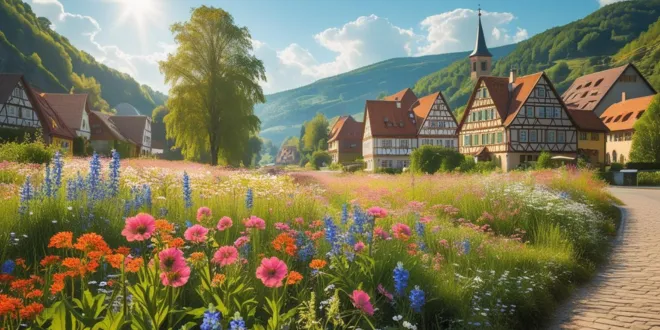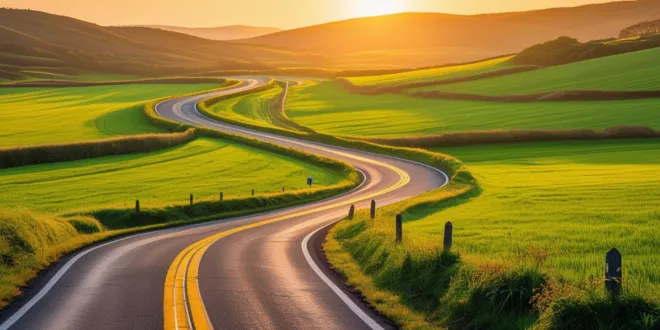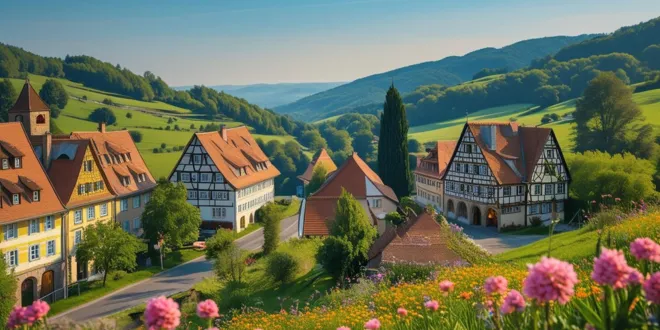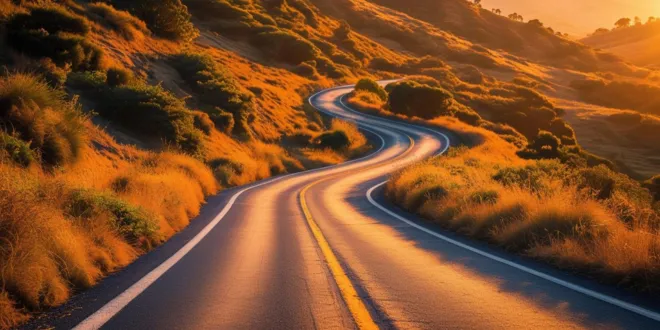Germany’s Romantic Road is one of Europe’s most scenic and enchanting routes, stretching about 350 kilometers from Würzburg in the north to Füssen in the south.
Lined with medieval towns, rolling vineyards, and fairytale castles, this famous route offers a journey through the heart of Bavaria and Baden-Württemberg’s most picturesque landscapes.
If you’re wondering how to plan a trip on the Romantic Road, the best approach is to explore its charming towns at a relaxed pace — whether by car or public transport.
Driving the Romantic Road gives you the freedom to stop at hidden gems and panoramic viewpoints, while also making it easy to visit the top castles on the Romantic Road you can’t miss, including the iconic Neuschwanstein Castle.
Each town along the way has its own unique character — from the well-preserved walls of Rothenburg ob der Tauber to the baroque elegance of Würzburg.
The best time to experience this journey is during spring or early autumn, when crowds are smaller and the scenery is at its most vibrant.
While some travelers debate Romantic Road vs Black Forest, the Romantic Road stands out for its storybook towns and historic charm.
Whether you’re planning a weekend getaway or a week-long adventure, discovering the best towns on Germany’s Romantic Road promises a magical blend of culture, history, and old-world romance.

Best Towns on Germany’s Romantic Road
- Rothenburg ob der Tauber
- Dinkelsbühl
- Füssen
- Augsburg
- Würzburg
- Nördlingen
- Esslingen
- Bad Mergentheim
Rothenburg ob der Tauber
A perfectly preserved medieval town with half-timbered houses and city walls.
Dinkelsbühl
Charming, fairy-tale atmosphere with cobblestone streets and historic architecture.
Füssen
Gateway to Neuschwanstein Castle, nestled in the Bavarian Alps.
Augsburg
One of Germany’s oldest cities, rich in Roman history and Renaissance buildings.
Würzburg
Elegant baroque architecture and a UNESCO-listed Residenz palace.
Nördlingen
A unique circular town built inside a meteorite crater.
Esslingen
A picturesque wine town near Stuttgart with a well-preserved old town.
Bad Mergentheim
Known for its spa culture and historic Teutonic Order castle.
How to Plan a Trip on the Romantic Road
Planning a trip on Germany’s Romantic Road starts with choosing your route, which stretches about 350 km from Würzburg to Füssen. Decide whether you’ll drive, use public transport, or join a guided tour. Allocate 5–7 days to fully enjoy the scenic towns and attractions. Book accommodations in advance, especially in popular spots like Rothenburg or Füssen.
Research opening times for castles and museums. Pack comfortable shoes for walking through historic centers. Consider purchasing a Bavaria Ticket for regional train travel. Plan for seasonal events like Christmas markets or summer festivals. Include must-see stops like Neuschwanstein Castle and the Würzburg Residenz.
Download offline maps and a translation app for convenience. Don’t forget to try local specialties like Schäufele (pork shoulder) and Franconian wine. With thoughtful planning, your Romantic Road journey will be a memorable blend of history, culture, and scenic beauty.

Driving the Romantic Road
Driving the Romantic Road offers a scenic and flexible way to explore Germany’s most charming towns and countryside. The route winds through Bavaria and Baden-Württemberg, connecting medieval villages, vineyards, and castles. Well-marked roads make navigation easy, though some town centers are car-free, requiring parking on the outskirts.
Allow plenty of time—rushing defeats the road’s leisurely spirit. Scenic highlights include the rolling hills of Tauber Valley and the Alpine views near Füssen. Drive cautiously on narrow, winding roads, especially in fog or rain.
Parking is available in designated lots, often a short walk from town centers. Renting a car gives you freedom to stop at hidden gems like small wineries or viewpoints.
Be mindful of speed limits and Autobahn sections nearby. With a well-planned itinerary and a sense of adventure, driving the Romantic Road becomes an unforgettable journey through Germany’s cultural heart.
When to Visit the Romantic Road in Germany
The best time to visit the Romantic Road is late spring through early autumn, from May to September, when the weather is mild and landscapes are lush.
Summer offers long days, vibrant festivals, and open-air markets, perfect for exploring towns like Rothenburg and Dinkelsbühl. July and August are peak tourist months, so book accommodations early.
Spring brings blooming flowers and fewer crowds, ideal for peaceful sightseeing. Fall, especially September and October, features beautiful foliage and wine harvest festivals in Franconia.
Winter, particularly December, transforms the region into a Christmas wonderland, with famous markets in Rothenburg and Würzburg drawing visitors worldwide.
However, some attractions have limited hours in winter. If you prefer milder weather and fewer tourists, consider visiting in May or September. Avoid major holidays if possible.
Regardless of season, each time of year offers a unique charm, from snowy medieval streets to sun-drenched vineyards, making the Romantic Road a year-round destination.

Romantic Road vs Black Forest
The Romantic Road and the Black Forest are both iconic German destinations, but they offer different experiences. The Romantic Road stretches 350 km from Würzburg to Füssen, focusing on fairy-tale towns, medieval architecture, and royal castles like Neuschwanstein. It’s ideal for history lovers and those seeking picturesque villages with cobbled streets and half-timbered houses.
In contrast, the Black Forest, located further west, is known for its dense woodlands, mountain scenery, hiking trails, and cuckoo clocks.
It’s more nature-oriented, offering outdoor activities like skiing, cycling, and thermal spa visits in towns like Baden-Baden. While the Romantic Road emphasizes cultural heritage and romanticized history, the Black Forest highlights natural beauty and traditional crafts.
The two regions can be combined for a comprehensive trip, as they’re within a few hours’ drive. Travelers seeking charming towns and castles will prefer the Romantic Road, while those craving forests, fresh air, and relaxation may lean toward the Black Forest. Both showcase Germany’s diverse landscapes and rich traditions.
Top Castles on the Romantic Road You Can’t Miss
- Neuschwanstein Castle
- Hohenschwangau Castle
- Harburg Castle
- Marienburg Castle
- Löwenstein Castle
- Burghausen Castle
- Steinsberg Castle
Neuschwanstein Castle
The iconic fairy-tale castle that inspired Disney’s Sleeping Beauty.
Hohenschwangau Castle
The royal family’s summer residence, located below Neuschwanstein.
Harburg Castle
One of Germany’s oldest hilltop castles, with panoramic views.
Marienburg Castle
A Gothic-style palace near Würzburg with elegant interiors.
Löwenstein Castle
Ruined but dramatic, perched above the Neckar Valley.
Burghausen Castle
Though slightly off-route, it’s the longest castle complex in the world.
Steinsberg Castle
A lakeside ruin near Rothenburg, great for photos and hikes.

Conclusion
Exploring the best towns on Germany’s Romantic Road is like stepping into a storybook of medieval charm, alpine beauty, and Bavarian tradition.
From the cobbled streets of Rothenburg ob der Tauber to the elegant baroque architecture of Würzburg and the fairy-tale allure of Füssen near Neuschwanstein Castle, each destination offers a unique glimpse into Germany’s rich cultural heritage. These towns are not just stops along the way — they are the heart and soul of the journey.
Whether you’re planning a short getaway or a longer adventure, knowing how to plan a trip on the Romantic Road ensures you make the most of your experience.
Driving the Romantic Road remains the most popular option, giving you the flexibility to explore at your own pace and discover hidden gems off the beaten path. While public transport is available, having a car enhances access to remote castles and scenic overlooks.
The best time to visit, or when to visit the Romantic Road in Germany, is during late spring to early autumn for pleasant weather and fewer crowds — though winter brings its own magic with Christmas markets. Some travelers wonder about Romantic Road vs Black Forest, but the Romantic Road offers a more concentrated cultural and historical experience.
And no trip is complete without visiting the top castles on the Romantic Road you can’t miss, especially Neuschwanstein and Hohenschwangau. In the end, this journey is more than a road trip — it’s a passage through Germany’s romantic past.
Frequently Asked Questions
1. What are the best towns to visit on Germany’s Romantic Road?
Some of the best towns on Germany’s Romantic Road include Rothenburg ob der Tauber, Füssen, Würzburg, Dinkelsbühl, Nördlingen, and Harburg. Each offers well-preserved medieval architecture, charming old towns, and scenic landscapes.
Rothenburg is famous for its intact city walls, while Füssen serves as the gateway to Neuschwanstein Castle. These towns blend history, culture, and fairytale beauty, making them must-see stops on this iconic route through Bavaria and Baden-Württemberg.
2. Which town on the Romantic Road is most worth visiting?
Many consider Rothenburg ob der Tauber the most worth visiting on the Romantic Road. This beautifully preserved medieval town features cobblestone streets, half-timbered houses, and a complete ring of city walls. Highlights include the Town Hall, St. Jakob’s Church, and the famous Night Watchman Tour.
Its storybook charm, rich history, and year-round appeal make Rothenburg a standout destination and a favorite among travelers exploring Germany’s most scenic route.
3. Is Rothenburg ob der Tauber worth visiting?
Yes, Rothenburg ob der Tauber is absolutely worth visiting. It’s one of Germany’s best-preserved medieval towns, with intact city walls, towers, and a picturesque old town.
Whether you’re exploring the Marienkapelle, walking the city walls, or enjoying local Franconian cuisine, the town offers a magical atmosphere. Its famous Christmas market adds winter charm. Rothenburg provides a unique, immersive experience that captures the essence of the Romantic Road.
4. How many days do you need to drive the Romantic Road?
To comfortably drive and explore the Romantic Road, plan for 5 to 7 days. This allows time to visit major towns like Rothenburg, Dinkelsbühl, and Füssen, and to tour Neuschwanstein Castle without rushing.
While it’s possible to cover the route in 2–3 days, a slower pace lets you enjoy scenic stops, local food, and hidden gems. For a full experience, include overnight stays and day trips to nearby attractions.
5. What is the best way to travel the Romantic Road – car or public transport?
The best way to travel the Romantic Road is by car, as it offers maximum flexibility to explore small towns and scenic viewpoints at your own pace. While public transport (trains and buses) connects major stops like Würzburg and Füssen,
it’s less reliable for reaching remote villages and castles. Renting a car enhances the road trip experience, making it easier to access parking, viewpoints, and rural accommodations along this picturesque route.
6. Can you do the Romantic Road in one day?
Technically, you can drive the full Romantic Road in one day, as it takes about 6–7 hours without stops. However, doing it in one day means missing the charm of the towns, castles, and scenic views.
The Romantic Road is about the journey, not just the destination. For a meaningful experience, spend several days exploring. A one-day trip only works if you’re traveling between cities and making one quick stop, like Neuschwanstein.
7. Which towns on the Romantic Road have Christmas markets?
Several towns on the Romantic Road host charming Christmas markets, especially during Advent. Top ones include Rothenburg ob der Tauber, famous for its magical “Reiterlesmarkt”; Nördlingen,
with a cozy market in the historic town square; Dinkelsbühl, known for its children’s Christmas market; and Würzburg, offering a large, elegant market near the Residence. These markets feature handmade crafts, mulled wine, and traditional treats, making the Romantic Road a winter wonderland.
8. Where should I stay overnight on the Romantic Road?
Great overnight stops on the Romantic Road include Rothenburg ob der Tauber, Dinkelsbühl, Füssen, and Würzburg. These towns offer charming hotels, guesthouses, and historic inns within walking distance of main attractions.
Staying in Rothenburg or Dinkelsbühl gives a true medieval atmosphere, while Füssen is ideal for visiting Neuschwanstein. Booking in advance is recommended, especially during peak seasons like summer and Christmas, to secure the best locations and rates.
9. Are the towns on the Romantic Road walkable?
Yes, most towns on the Romantic Road are highly walkable. Their compact historic centers are designed for pedestrians, with cobbled streets, central squares, and key attractions within easy reach.
Rothenburg, Dinkelsbühl, and Nördlingen can be fully explored on foot in a few hours. Comfortable shoes are recommended due to uneven surfaces. Parking is usually on the outskirts, so you’ll walk into town anyway — making walking the best way to experience their charm.
10. What is the most picturesque town on the Romantic Road?
Many consider Rothenburg ob der Tauber the most picturesque town on the Romantic Road. With its colorful half-timbered houses, medieval city walls, and snow-dusted rooftops in winter, it looks like a scene from a fairy tale.
The town’s well-preserved architecture, panoramic views from the town walls, and enchanting lighting at dusk make it a top photography spot. Other contenders include Dinkelsbühl and Nördlingen, but Rothenburg’s timeless beauty stands out.
